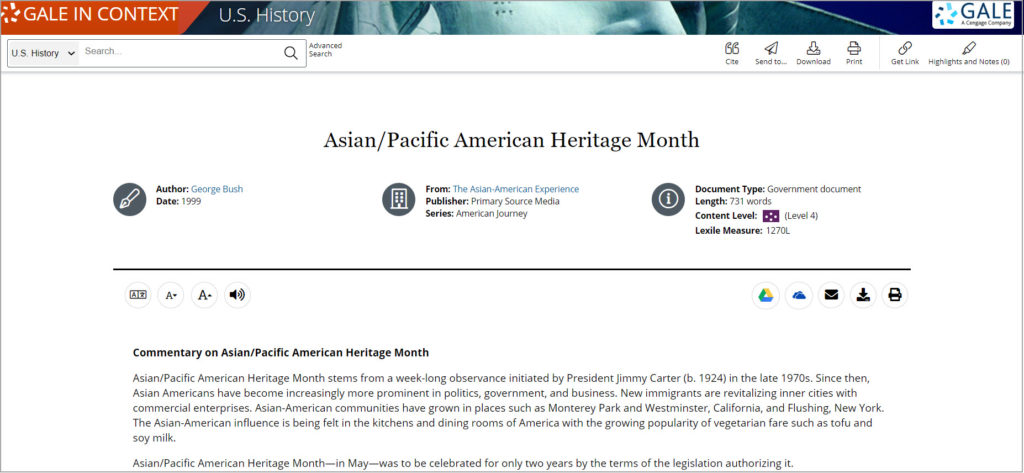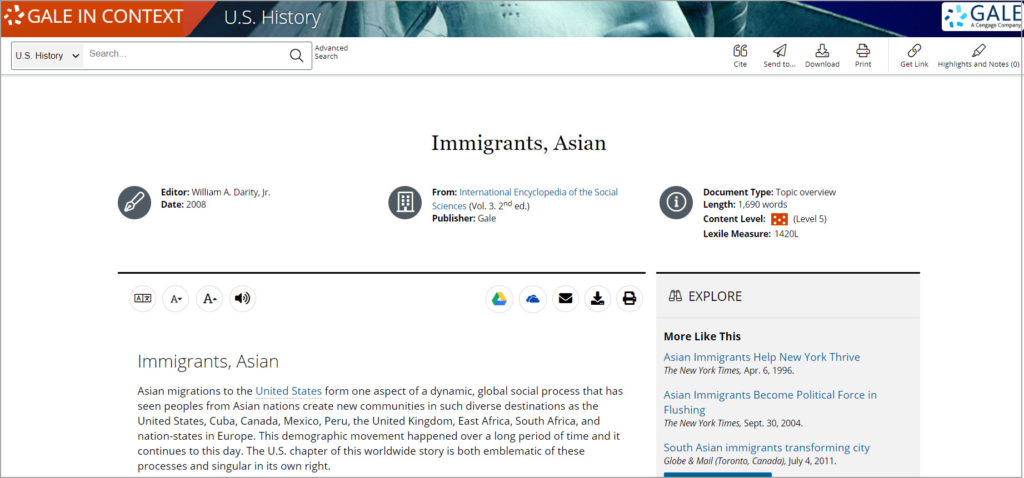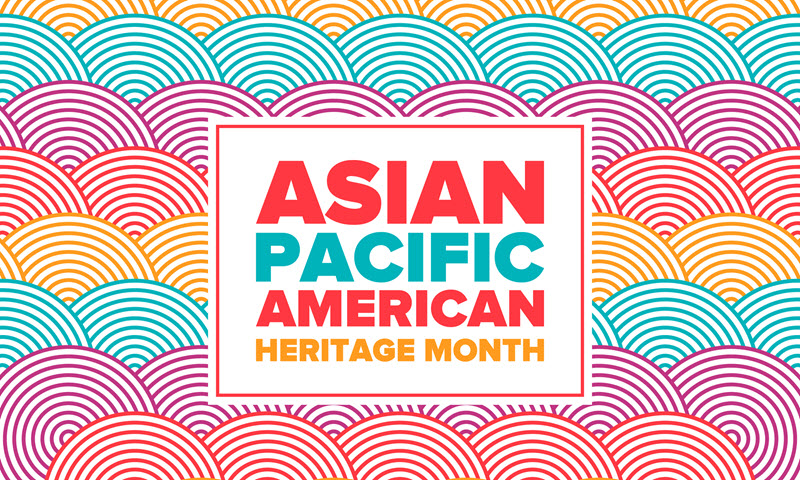| By Tara Atterberry |
The first national recognition of Americans of Asian and Pacific Island heritage was instituted by U.S. President Jimmy Carter in 1978. Carter established the first 10 days of May as Asian/Pacific American Heritage Week. This resolution was intended to celebrate two milestones in Asian American and Pacific Islander history: the arrival of the first Japanese immigrants to U.S. soil on May 7, 1843, and the completion of the transcontinental railroad on May 10, 1869, built largely by Chinese workers who had immigrated to the United States in the 1850s and ‘60s.1
President George Bush later expanded this recognition in 1991 by establishing May as Asian/Pacific Islander Heritage Month:2
The Asian/Pacific American heritage is marked by its richness and depth. The world marvels at the wealth of ancient art and philosophy, the fine craftsmanship, and the colorful literature and folklore that have sprung from Asia and the Pacific Islands. Whether they trace their roots to places like Cambodia, Vietnam, Korea, the Philippines, and the Marshall Islands or cherish their identities as natives of Hawaii and Guam, all Asian and Pacific Americans can take pride in this celebration of their heritage.
— George Bush, May 5, 1991

Americans of Pacific Island descent are those who hail from the Pacific Islands region of the Pacific Ocean, including the Marshall Islands, Northern Mariana Islands, Palau, French Polynesia, Tonga, Samoa, American Samoa, and native Hawaiians, among others. While not accurately documented, the first Pacific Islanders who arrived on the North and South American western coast were likely Polynesian sea explorers, coming to the New World hundreds of years before Europeans reached the Eastern coast of North America in the 1500 and 1600s.3
Thousands of additional Pacific Islanders came under the United States’ umbrella through colonization in the 1800s. The first Pacific Islanders granted legal resident status were French Polynesians in 1843 and individuals from Fiji in 1874, according to the U.S. Department of Homeland Security. Shortly following World War II, individuals from Melanesia and Micronesia immigrated to the United States, followed later by larger numbers of immigrants from Tonga and Samoa in the late 1940s and early 1950s.4 In an effort to document this group of ethnicities more accurately, the U.S. Census Bureau added the category of Native Hawaiian and Other Pacific Islander in 2000.5
The first large waves of Asian immigration into the United States began in the 1840s and ‘50s, as hundreds of thousands of Asian persons, predominately of Chinese descent, immigrated through California’s coast to participate in the gold rush and later to pursue work in California’s growing cities and on the intercontinental railroad. There are estimates that more than 320,000 Chinese immigrated to the United States’ West Coast from 1850 to 1882.6 However, Asian immigration to the United States began decades before the 1840s, with smaller numbers of Asians arriving on the East Coast. In 1763, ship workers from the Philippines, referred to as the “Manila men,” were part of the community in what today is Louisiana, while small groups of Asians were working as indentured servants in Pennsylvania and Massachusetts in the 1780s and 1790s, with more than 150 Chinese employed as cooks, sailors, and ship workers in New York by 1856.7

A large, varied, and active sector of America’s culture and economy, persons of Asian and Pacific Island heritage now number more than an estimated 25 million U.S. residents. Recently, the U.S. Census Bureau reported that there were more than 1.6 million persons of Pacific Islander heritage living in the United States in 2019, with the largest group of over 800,000 of these persons being from native Hawaiian or Samoan descent.8 The 2019 U.S. Census Bureau statistics also assert that there are currently nearly 23 million persons of Asian descent living in the United States. Individuals of Chinese heritage account for the largest percentage of this group, with 8.5 million persons, followed by 4.6 million Asian Indians, 4.2 million Filipinos, 2.2 million Vietnamese, 1.9 million Korean, and 1.5 million Japanese.9
We take the month of May to honor and highlight their backgrounds, contributions, and achievements:10
Time and again throughout our Nation’s history, Asian and Pacific Americans have proved their devotion to the ideals of freedom and democratic government. Those ideals animate and guide our policies toward Asia and the Pacific today. The economic dynamism of the Pacific Rim is a crucial source of growth for the global economy, and the United States will continue working to promote economic cooperation and the expansion of free markets throughout the region. The United States also remains committed to the security of our allies and to the advancement of human rights throughout Asia and the Pacific. We proudly unite in observing Asian/Pacific American Heritage Month.
— George Bush, May 6, 1991
Gale is pleased to celebrate Asian American and Pacific Islander heritage by providing a variety of products that offer content on the history, art, culture, challenges, and accomplishments of this diverse group of individuals. Please contact a Gale sales representative to request a trial of the following products or many of Gale’s other excellent resources:
- Passenger and Immigration Lists Index on the Gale Directory Library. Provides content related to 300 years of Asian and Pacific Islander immigration to the New World.
- Biography and Genealogy Master Index on the Gale Directory Library. Provides biographical citations for more than 50,000 Asian and Pacific Islanders from all times in history.
- Gale In Context: U.S. History and Gale In Context: World History. Provides detailed reference articles, images, primary sources, videos, and more, on all aspects of this group of individuals throughout history.
1. U.S. Census 2020. “Asian American and Pacific Islander Heritage Month: May 2021.” Accessed May 15, 2021.
2. Bush, George. “Asian/Pacific American Heritage Month.” The Asian-American Experience. American Journey. Woodbridge, CT: Primary Source Media, 1999. Gale In Context: U.S. History (accessed May 13, 2021).
3. Swain, Liz. “Pacific Islander Americans.” In Gale Encyclopedia of Multicultural America, 3rd ed., edited by Thomas Riggs, 401‒410. Vol. 3. Gale, 2014. Gale In Context: U.S. History (accessed May 14, 2021).
4. See note 3.
5. See note 3.
6. Benson, Sonia, Daniel E. Brannen, Jr., and Rebecca Valentine. “Asian Immigration.” In UXL Encyclopedia of U.S. History, 97‒104. Vol. 1. Detroit, MI: UXL, 2009. Gale In Context: U.S. History (accessed May 17, 2021).
7. “Immigrants, Asian.” In International Encyclopedia of the Social Sciences, 2nd ed., edited by William A. Darity, Jr., 562‒564. Vol. 3. Detroit, MI: Macmillan Reference USA, 2008. Gale In Context: U.S. History (accessed May 13, 2021).
8. See note 1.
9. See note 1.
10. See note 1.

Meet the Author
Tara Atterberry has been with Gale for 26 years and manages biography and genealogy content. She is an avid history and genealogy buff and, when not digging through biographies and historical documents, enjoys scrapbooking; going to estate sales; and spending time with her family, friends, and three cats.

